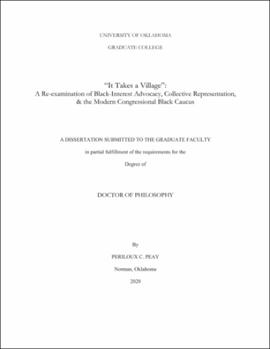| dc.description.abstract | This project has three explicit goals in mind. First, I aim to uncover how the CBC constructs and communicates their collective worldview to the institution. Existing literature has been essential to improving our understanding of how Black lawmakers behave in legislative bodies. However, it often falls short in considering, empirically, the contexts and commitments that are wrapped up in their agenda. Second, I seek to move beyond studying individualized legislative behaviors to examine how collective strategies are employed to promote their preferences onto the institution’s agenda. Finally, by working at the intersection of institutional and policy process literature and drawing on seldom-used methodological tools, I hoped to build on theoretical and empirical explorations into the representations of Black America in the House of Representatives.
Chapter 2 examines the potential of evaluating floor speeches delivered with the intent of defining issues on their agenda. By defining policies according to their underlying attributes, Black lawmakers are able to shape policy images and shape – and potentially reshape – existing frames of policy issues that plague the communities that they represent. I also uncover that there is a decided utility in engaging in problem definition from a scholarly, organizational, and institutional perspective. A better understanding of issues provides policy actors a bit of clarity in taking on problems faced by Black Americans. In Chapter 3, I attempt to apply a theoretical explanation to changes in bill sponsorship trends in recent congressional sessions. I argue that the CBC a striking increase in legislation that receives multiple committee referrals is tied to an effort to broaden the reach of legislation within the chamber. Doing so increases the likelihood that these bills clear the committee stage. Chapter 4 set out to explore how the Black Caucus responded to institutional adversity. I find that the organization consolidated its messaging efforts through bill cosponsorship in the midst of a long-term stent in the minority party. This can potentially free up committee chairs to do the work of the party while rank and file members can invest their time and effort into issue advocacy.
Taken together, it is my hope that the preceding chapters serve as a first step in re-examining the collective representation of Black interest in Congress. In doing so, I find it essential that we invest in updating our understanding of the modern Congressional Black Caucus as they increase in numbers, influence, and outcomes. This is much different than investigating the behavior Black lawmakers. Examining the Caucus means, first, examining the caucus in a way that distinguishes the organization from the preferences and behaviors of individual Black lawmakers. This also means that there should be a considerable amount of effort devoted to bringing to light organizational features and strategies that shape the collective behavior within the chamber. To this end, I prescribe four avenues that researchers should consider to broaden the examination of Black representation. | en_US |
